Roman mosaic and villa complex found in Rutland farmer's field
 Historic England
Historic EnglandA Roman villa containing a rare mosaic that depicts scenes from Homer's Iliad has been found beneath a farmer's field.
The mosaic, found in Rutland, has been described as the first example of its kind in the UK.
It was discovered by the landowner's son and investigated by archaeologists from the University of Leicester.
Historic England described the mosaic as "one of the most remarkable and significant... ever found in Britain".
The mosaic and surrounding villa complex have now been protected as a Scheduled Monument by the Department for Digital, Culture, Media and Sport (DCMS) on the advice of Historic England.
The complex is thought to have been occupied by a wealthy individual from the late Roman period.
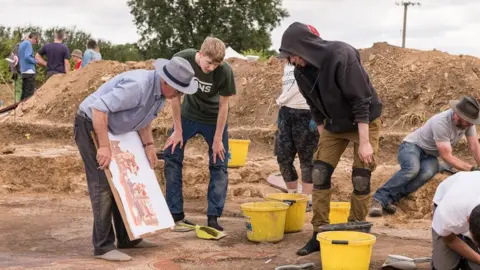 Historic England
Historic EnglandJim Irvine, son of landowner Brian Naylor, made the initial discovery after spotting "unusual pottery" on a walk during the 2020 lockdown, and contacted the archaeological team at Leicestershire County Council.
He said: "My family have been farming this land for 50 or 60 years.
"During lockdown last year, I noticed some pottery on the ground which didn't look like any pottery I'd seen before.
"We came down here with a spade and I dug a shallow trench and I was in exactly the right place.
"To see something that has been undisturbed for 1700 years or so has been amazing.
"The thing that has been keeping me interested is what's the state of the next thing to come out of the site because it's all been amazing so far."
Historic England funded urgent excavation work at the site by the University of Leicester.
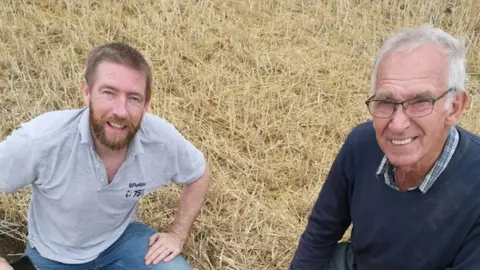 Historic England
Historic EnglandThe mosaic, which forms the floor of what was thought to be a dining or entertaining area of the villa, measures 11m x 7m (36ft x 23ft).
Mosaics were regularly used in private and public buildings across the Roman Empire, and often featured famous figures from mythology.
However, the Rutland mosaic is thought to be unique in the UK as it features Achilles and his battle with Hector at the conclusion of the Trojan War.

Analysis
By Phil Mackie, BBC Midlands correspondent at the scene
I know where the villa was found but I'm not allowed to give away too many details. It's because they don't want anyone coming along and trying to carry out their own investigations and disturbing the site.
For now, the mosaic has been covered back up. It's been well protected for more than a millennium and a half beneath a 2ft (0.6m) layer of soil, and it won't come to any further harm now it's back underground.
Jim Irvine really hopes that people will be able to come to visit in situ one day but decisions about its long-term future haven't been made yet.
The site is so big that only a tiny part of the complex has been excavated. There are likely to be more discoveries in the digging seasons to come.

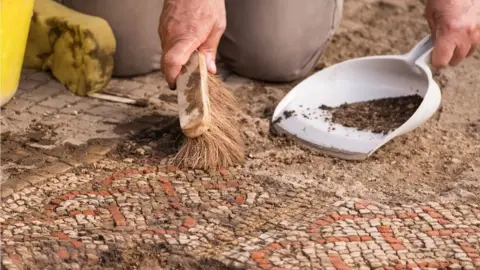 Historic England
Historic EnglandInvestigations have revealed the large villa is surrounded by barns, circular structures and possibly a bath house.
The complex is likely to have been occupied by someone with a knowledge of classical literature, between the 3rd and 4th Century AD.
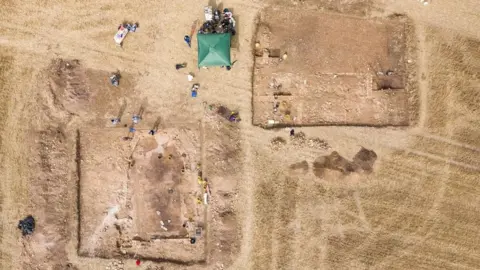 Historic England
Historic EnglandJohn Thomas, deputy director of the University of Leicester Archaeological Services and project manager on the excavations, said: "This is certainly the most exciting Roman mosaic discovery in the UK in the last century.
"It gives us fresh perspectives on the attitudes of people at the time, their links to classical literature, and it also tells us an enormous amount about the individual who commissioned this piece.
"This is someone with a knowledge of the classics, who had the money to commission a piece of such detail, and it's the very first depiction of these stories that we've ever found in Britain."
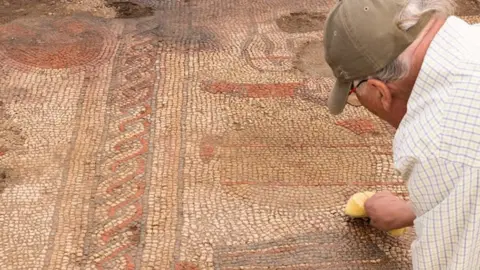 Historic England
Historic EnglandDuncan Wilson, chief executive of Historic England, added: "To have uncovered such a rare mosaic of this size, as well as a surrounding villa, is remarkable.
"Discoveries like this are so important in helping us piece together our shared history. By protecting this site we are able to continue learning from it, and look forward to what future excavations may teach us about the people who lived there over 1,500 years ago."
The site is on private land and not accessible to the public but discussions are ongoing with Rutland County Council to set up an off-site display of the villa complex and its finds, Historic England said.
Further excavations are planned on the site in 2022.
Mr Irvine said the field will no longer be used for farming so the area can be protected.
The discovery of the Rutland villa will be featured as part of Digging for Britain on BBC Two and iPlayer in early 2022.

Follow BBC East Midlands on Facebook, Twitter, or Instagram. Send your story ideas to [email protected].
